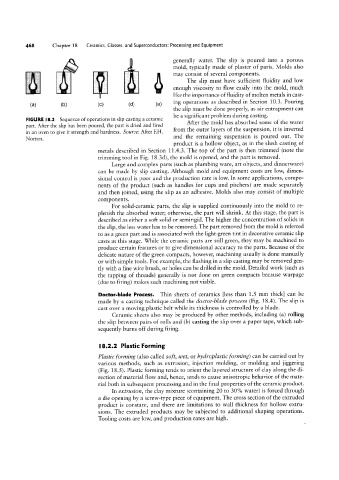Page 488 - 04. Subyek Engineering Materials - Manufacturing, Engineering and Technology SI 6th Edition - Serope Kalpakjian, Stephen Schmid (2009)
P. 488
468 Chapter 18 Ceramics, Glasses. and Superconductors: Processing and Equipment
$ generally water. The slip is poured into a porous
mold, typically made of plaster of paris. Molds also
E
may consist of several components.
The slip must have sufficient fluidity and low
M T i enough viscosity to flow easily into the mold, much
like the importance of fluidity of molten metals in cast-
ing operations as described in Section 10.3. Pouring
(3) (U) (C) (d) (6)
the slip must be done properly, as air entrapment can
be a significant problem during casting.
FIGURE l8.3 Sequence of operations in slip casting a ceramic After the mold has absorbed some of the water
part. After the slip has been poured, the part is dried and fired
in an oven to give it strength and hardness. Source: After PH. from the outer layers of the suspension, it is inverted
Norton. and the remaining suspension is poured out. The
product is a hollow object, as in the slush casting of
metals described in Section 11.43. The top of the part is then trimmed (note the
trimming tool in Fig. 18.3d), the mold is opened, and the part is removed.
Large and complex parts (such as plumbing ware, art objects, and dinnerware)
can be made by slip casting. Although mold and equipment costs are low, dimen-
sional control is poor and the production rate is low. In some applications, compo-
nents of the product (such as handles for cups and pitchers) are made separately
and then joined, using the slip as an adhesive. Molds also may consist of multiple
components.
For solid-ceramic parts, the slip is supplied continuously into the mold to re-
plenish the absorbed water; otherwise, the part will shrink. At this stage, the part is
described as either a soft solid or semirigid. The higher the concentration of solids in
the slip, the less water has to be removed. The part removed from the mold is referred
to as a green part and is associated with the light-green tint in decorative ceramic slip
casts at this stage. While the ceramic parts are still green, they may be machined to
produce certain features or to give dimensional accuracy to the parts. Because of the
delicate nature of the green compacts, however, machining usually is done manually
or with simple tools. For example, the flashing in a slip casting may be removed gen-
tly with a fine wire brush, or holes can be drilled in the mold. Detailed work (such as
the tapping of threads) generally is not done on green compacts because warpage
(due to firing) makes such machining not viable.
Doctor-blade Process. Thin sheets of ceramics [less than 1.5 mm thick] can be
made by a casting technique called the doctor-blade process (Pig. 18.4). The slip is
cast over a moving plastic belt while its thickness is controlled by a blade.
Ceramic sheets also may be produced by other methods, including (a) rolling
the slip between pairs of rolls and (b) casting the slip over a paper tape, which sub-
sequently burns off during firing.
|8.2.2 Plastic Forming
Plastic forming (also called soft, wet, or /vydroplastic forming) can be carried out by
various methods, such as extrusion, injection molding, or molding and jiggering
(Fig. 18.5 ). Plastic forming tends to orient the layered structure of clay along the di-
rection of material flow and, hence, tends to cause anisotropic behavior of the mate-
rial both in subsequent processing and in the final properties of the ceramic product.
In extrusion, the clay mixture (containing 20 to 30% water) is forced through
a die opening by a screw-type piece of equipment. The cross section of the extruded
product is constant, and there are limitations to wall thickness for hollow extru-
sions. The extruded products may be subjected to additional shaping operations.
Tooling costs are low, and production rates are high.

